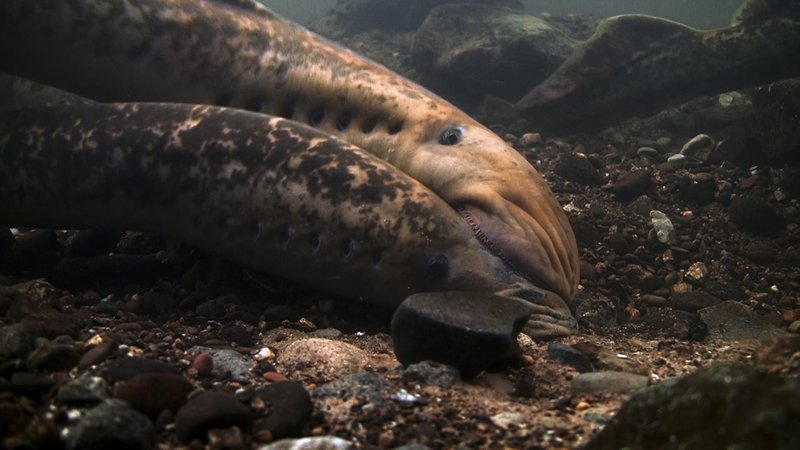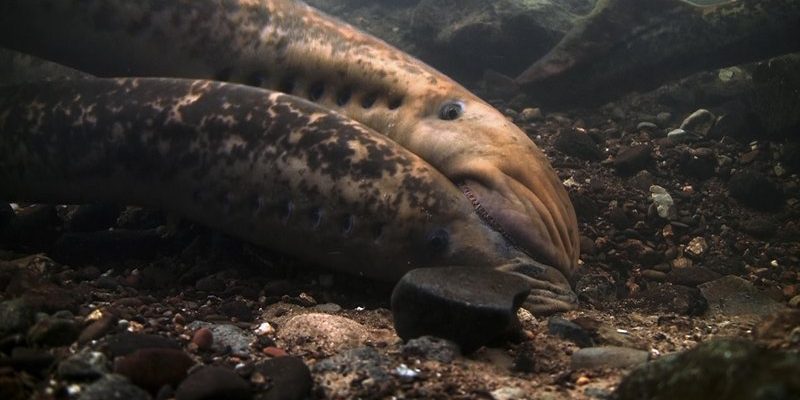
When you think of fish, you probably picture the typical ones, like salmon or trout, right? But there’s a fascinating creature swimming around in our oceans and rivers that might surprise you: the lamprey. These remarkable creatures are jawless fish, known for their elongated bodies and distinctive, sucker-like mouths. Imagine a living vacuum cleaner that can cling to other fish, sucking their blood—that’s what a lamprey does. They are unlike most other fish you’ll encounter, and their unique feeding habits make them as interesting as they are unusual.
Lampreys belong to the class Petromyzontida, which dates back to ancient times—some hundreds of millions of years ago. They have existed long before dinosaurs roamed the Earth! This alone makes them a subject of interest for scientists and nature enthusiasts alike. As they explore their aquatic habitats, you might be curious about how these peculiar fish live, where they come from, and what makes them stand out in a world filled with more conventional fish species.
Physical Characteristics of Lampreys
So, what do lampreys look like? These creatures may not win any beauty contests, but their unique structure is quite fascinating. Lampreys generally have an elongated, cylindrical body, resembling a snake more than a fish. They can grow anywhere from 5 to 40 inches long, with some species even longer! Their skin is slimy and often a grayish or brownish color, which helps them blend into their natural surroundings, making them effective predators.
The real standout feature of a lamprey is its mouth. Instead of a traditional jaw, they have a round, sucker-like mouth filled with sharp, rasping teeth. This unique mouth structure allows them to attach themselves to other fish. When they find a host, they use their teeth to latch on and suck blood, much like a leech. While this might sound gruesome, it’s part of their natural feeding behavior.
Interestingly, lampreys have no paired fins or bones, which is another reason they’re classified separately from most fishes. Instead, they have a cartilaginous skeleton—similar to sharks—and they lack scales. This unique body plan gives them a streamlined shape that aids in swimming along riverbeds and in open water.
The Habitat of Lampreys
Lampreys are quite versatile when it comes to their habitat. They can be found in both freshwater and saltwater environments around the world. These fish thrive in rivers, lakes, and even coastal areas where they can find suitable hosts. They migrate between these bodies of water during different stages of their life cycle, showcasing their adaptability.
During their larval stage, known as ammocoetes, lampreys live in the soft sediments of streams and rivers. They spend several years feeding on organic matter and microorganisms, growing in size before transitioning into their adult form. Once they mature, lampreys migrate to the open waters of lakes or oceans to seek out hosts for feeding. This two-phase life cycle reflects their remarkable adaptability to changing environments.
If you happen to be near a river, you might find lampreys navigating the water with their elongated bodies. They prefer habitats with clean, well-oxygenated water, and they often migrate upstream to spawn. This journey can be perilous, but it highlights their tenacity and determination. If you ever catch a glimpse of a lamprey, consider it a rare treat—these creatures are truly one-of-a-kind!
Feeding Habits of Lampreys
Feeding is where lampreys really show off their unique adaptations. As mentioned earlier, they are parasitic, meaning they rely on other fish for food. Their feeding process is quite graphic: the lamprey attaches to its host with its sucker mouth, using its sharp teeth to create a wound. Once attached, it starts to suck the host’s blood and bodily fluids, often leaving the fish weakened or even dead.
But not all lampreys are bloodsuckers. Some species exhibit different feeding behaviors, eating algae or plankton instead. These non-parasitic lampreys have a completely different impact on their ecosystem. They play essential roles in various aquatic habitats. Their feeding practices can have both positive and negative effects on fish populations and the health of ecosystems.
The process of feeding can take a toll not only on the host fish but also on the lamprey if they’re not careful. If the host fish manages to shake off the lamprey, it may be wounded or even die from infection. This delicate balance showcases the struggle of survival in nature. And while lampreys may get a bad rap for being bloodsuckers, it’s essential to recognize their role in maintaining the health of their ecosystems.
Reproductive Behavior of Lampreys
Now that we’ve covered their feeding habits, let’s dive into lampreys’ reproductive behavior. Lampreys are fascinating when it comes to mating, and their life cycle reflects their unique evolutionary adaptations. They typically migrate upstream to spawn in shallow, gravelly areas. During this time, males will create nests and perform elaborate courtship displays, which could include wriggling and swimming around to attract females.
Once a female selects a mate, they’ll lay thousands of eggs together in the nest made by the male. After fertilization, the adult lampreys die, leaving the eggs to hatch on their own. The larvae, known as ammocoetes, will go through several years of development before emerging as adults. This method of reproduction ensures that lampreys can rapidly increase their numbers, even after adult mortality.
Interestingly, the entire process of converting from larvae to adult takes several years, which is quite a long time in the aquatic world. However, this slow development allows the young lampreys to grow strong and healthy before they venture out to seek hosts. It’s a reminder of how different life strategies can exist in nature, and how adaptation plays a key role in survival.
Conservation and Lamprey Threats
Like many wildlife species, lampreys face a range of threats due to human activities and environmental changes. Habitat destruction, pollution, and climate change can significantly impact their populations, especially since they rely on clean water for survival. Dams and other barriers can block migratory paths, making it difficult for them to reproduce.
In some regions, lampreys are considered invasive species, which has led to controversial management efforts. For instance, the sea lamprey has been blamed for diminishing fish populations in the Great Lakes, prompting various control methods. These management strategies can often be complex, as they must balance ecological health with economic interests connected to fishing.
Conservation efforts are essential to ensure the survival of lamprey populations. By protecting their habitats, reducing pollution, and educating the public about their ecological roles, we can help maintain the delicate balance of our waterways. Understanding the significance of these ancient creatures is key to preserving them for generations to come.
Interesting Facts About Lampreys
| Fact | Description |
| Ancient Creatures | Lampreys have existed for over 360 million years, predating dinosaurs! |
| Species Variety | There are about 38 species of lampreys worldwide. |
| Unique Mouth | Their sucker-like mouth allows them to attach to hosts easily. |
| Life Cycle | They can spend several years in their larval stage before maturing. |
| Ecological Role | They serve as both predators and prey in aquatic ecosystems. |
Our Fascination with Lampreys
It’s easy to see why lampreys capture the imagination of so many. Their prehistoric look, unique feeding habits, and fascinating life cycle make them one of nature’s most compelling mysteries. Many people might find them creepy or off-putting, but there’s much more to lampreys than meets the eye. Their adaptations highlight the wonders of evolution and the intricate balance of life in aquatic ecosystems.
As you explore rivers or lakes, keep an eye out for these ancient creatures. Whether you spot them clinging to other fish or notice their larvae hiding in the sediment, you’re witnessing a part of natural history that has persisted for millions of years. There’s something profoundly humbling about sharing our planet with such unique animals, don’t you think?
FAQ
Are lampreys dangerous to humans?
No, lampreys are not dangerous to humans. While they do attach to fish and suck their blood, they rarely interact with people. However, if someone were to hold a lamprey, it might attach momentarily, but it poses no real threat.
How do lampreys find their hosts?
Lampreys have evolved sensory organs that help them detect chemical signals in the water, which can indicate the presence of potential hosts. They swim toward these signals, using their keen senses to locate fish nearby.
Do lampreys bite when they attach to a fish?
Yes, lampreys do bite when they attach to a fish. Their sharp teeth create a wound which allows them to suck blood. This is a natural part of their feeding behavior and is how they gain nutrients.
How long do lampreys live?
Lamprey lifespan varies by species, but most can live anywhere from 5 to 10 years. Some species may have shorter lifespans, while others can live longer if conditions are favorable.
Are lampreys harmful to the environment?
Lampreys can be harmful in certain contexts, especially when they invade areas where they are not native. For instance, the sea lamprey has negatively impacted fish populations in the Great Lakes, highlighting the importance of managing their populations responsibly.
Can lampreys be eaten?
While not commonly eaten in many cultures, some people do consume lampreys. In certain regions, they are considered a delicacy and can be prepared in various ways. However, their unique taste and texture might not appeal to everyone!
Do lampreys have predators?
Yes, lampreys do have natural predators. Larger fish, birds, and even some mammals can prey on lamprey, especially during their larval stage when they are less mobile and more vulnerable.
What is the biggest lamprey species?
The Pacific lamprey is one of the largest species, reaching lengths of up to 40 inches. It’s fascinating to think that even within this unique group of fish, there’s a variety of sizes and adaptations!
How do lampreys reproduce?
Lampreys reproduce by migrating upstream to spawn in shallow areas. Males create nests where females lay their eggs. After fertilization, the adults die, and the eggs hatch into larvae that will grow into mature lampreys over several years.
Are lampreys related to eels?
While lampreys and eels share a similar elongated body shape, they are not closely related. Lampreys belong to a separate class of jawless fish, while eels are bony fish. However, their appearance often leads to confusion!
What role do lampreys play in their ecosystem?
Lampreys occupy an important niche within aquatic ecosystems. As predators and prey, they help maintain the balance of species in their habitats. Their unique feeding behavior also affects the health of fish populations, illustrating their ecological significance.

